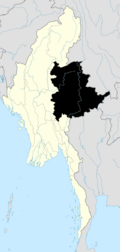Mong La
Mong La
မိုင်းလား / 勐拉 | |
|---|---|
 | |
| Coordinates: 21°39′50″N 100°02′24″E / 21.66389°N 100.04000°E | |
| Country | Myanmar |
| State | Shan |
| District | Kengtung District |
| Township | Mong La Township |
| Elevation | 640 m (2,100 ft) |
| Time zone | UTC+6:30 (MST) |
Mong La or Mongla (Burmese: မိုင်းလား Burmese pronunciation: [máɪɰ̃lá]; Chinese: 勐拉; pinyin: Měnglā), also known as Little Mong La (Chinese: 小勐拉; pinyin: Xiǎo Měnglā) to distinguish it from neighbouring Mengla County in China, is the administrative seat of Mong La Township in Shan State, Myanmar.
Mong La is opposite Daluo, a Chinese border town in Yunnan Province, It is about 258 kilometres (160 mi) from the Thai border town of Mae Sai and 80 kilometres (50 mi) north-east of Kengtung, Myanmar.
Although Mong La is in Myanmar, its electricity, telecommunications, other infrastructure, and trade flows are dependent on China.[2] The main currency used in Mong La is the Chinese yuan.[3]
Name
Mong La, Mengla and Meungla are differing Romanizations of the same Tai word. Both the e and the o should be pronounced like the Scottish pronunciation of u in bucks. To differentiate Mengla County in China and Mong La Township/settlement in Myanmar the locals call the former "Greater Mengla/Mongla" and the latter "Lesser Mongla/Mengla". Mengla Town in Jinping County also bears the same name but is too distant to cause confusion.
History
Mong La emerged from a small remote village in the 1990s to become a local version of Las Vegas. The National Democratic Alliance Army (NDAA) operates in the Mong La area.[2]
In 1995, the State Law and Order Restoration Council began construction of a replica of Shwedagon Pagoda in Mong La.[4] The pagoda was consecrated in 1997.
Mong La casinos were closed in January 2005 for about a year because of complaints from the Government of China.[5] Mong La has a history of rapid expansion, but in the late 2000s, its economy was in decline.[6] Tourism from Thailand to Mong La resumed in 2012 after the signing of new cease fire agreement between the Burmese military government and the Mong La NDAA in September 2011.[citation needed]
There has been an increase in illegal wildlife trafficking in the region. Mong La has emerged as a significant hub of the pangolin trade and during four visits in 2006, 2009, 2013–2014 and 2015, a total of 42 bags of pangolin scales, 32 whole skins, 16 foetuses or pangolin parts in wine and 27 whole pangolins were observed for sale.[7] Wildlife products from Africa, such as African elephant ivory and white rhino horn, have been observed openly for sale in Mong La, indicating this hub is being used to move such items into China.[8] [9]
There were reports that Chinese company Shanghai Shellpay Internet Technology has planned to construct the Yongbang Blockchain Special Economic Zone (SEZ) in Mong La. In February 2019, the Chinese Embassy in Myanmar released a statement on the creation of Yongbang SEZ. However, Mong La officials have denied that Chinese firms were permitted to set up a blockchain SEZ in the region.[10]
References
- ^ GoogleEarth
- ^ a b Michael Black and Roland Fields. "Virtual gambling in Myanmar's drug country".Asia Times 26 August 26, 2006
- ^ Star Publications Mongla escapade, LIZ PRICE, February 12, 2011 Archived 21 August 2014 at the Wayback Machine
- ^ "Forbidden Glimpses of Shan State" (PDF). Shan Women’s Action Network. November 2009.
- ^ Williams, China (15 September 2010). Thailand. Lonely Planet Publications. ISBN 978-1-74220-385-0. Retrieved 1 August 2021.
- ^ Gorsky, Timothy. "Christmas in Purgatory: Investigating the Illegal Wildlife Market in Mong La, Burma". Rabbit Advocacy. Retrieved 1 August 2021.
- ^ Nijman, Vincent; Zhang, Ming Xia; Shepherd, Chris R. (2016). "Pangolin trade in the Mong La wildlife market and the role of Myanmar in the smuggling of pangolins into China". Global Ecology and Conservation. 5: 118–126. doi:10.1016/j.gecco.2015.12.003.
- ^ Nijman, Vincent; Shepherd, Chris R. (1 November 2014). "Emergence of Mong La on the Myanmar–China border as a global hub for the international trade in ivory and elephant parts". Biological Conservation. 179: 17–22. doi:10.1016/j.biocon.2014.08.010. ISSN 0006-3207.
- ^ Shepherd, Chris R.; Gray, Thomas N.E.; Nijman, Vincent (2017). "Rhinoceros horns in trade on the Myanmar–China border". Oryx. 52 (2): 393–395. doi:10.1017/S003060531600168X. ISSN 0030-6053.
- ^ "Mongla Official Denies Chinese Firm Permitted to Set Up Autonomous Digital Economic Zone". The Irrawady.
External links
- Webarchive template wayback links
- Use dmy dates from August 2021
- Articles with short description
- Short description matches Wikidata
- Articles containing Burmese-language text
- Articles containing Chinese-language text
- Coordinates on Wikidata
- Pages with Burmese IPA
- All articles with unsourced statements
- Articles with unsourced statements from August 2021
- Township capitals of Myanmar
- Populated places in Shan State
- Tourism in Myanmar
- Special Economic Zones of Myanmar
- China–Myanmar border crossings


